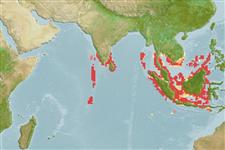>
Eupercaria/misc (Various families in series Eupercaria) >
Nemipteridae (Threadfin breams, Whiptail breams)
Etymology: Scolopsis: Name from the Greek masculine noun 'skolos' meaning 'thorn' and suffix '-opsis' (from Greek feminine n. 'opsis' meaning 'aspect', 'appearance') meaning ‘thorny appearance’ presumably referring to 'les dentelures de la préopercule, en ont aussi, et même d'épineuses, aux sous-orbitaires' mentioned by Cuvier (1814) in his designation of the genus. Name ending in -'opsis' are treated as feminine according to ICZN 1999: Article 30.1.2 (Ref. 130620).
Environment: milieu / climate zone / profondeur / distribution range
Écologie
marin récifal; profondeur 1 - 30 m (Ref. 48635). Tropical; 13°N - 12°S, 67°E - 120°E (Ref. 3810)
Indian Ocean: Maldives, Sri Lanka and southern Indonesia. This species has been reported by most authors under the name Scolopsis personatus, but Scolopsis auratus is the older name.
Taille / Poids / Âge
Maturité: Lm ? range ? - ? cm
Max length : 26.0 cm TL mâle / non sexé; (Ref. 90102); common length : 18.0 cm SL mâle / non sexé; (Ref. 3810)
Épines dorsales (Total) : 10; Rayons mous dorsaux (Total) : 9; Épines anales: 3; Rayons mous anaux: 7. Lower limb of preopercle scaly. Antrorse (forward-directed) suborbital spine absent. Pelvic fins long, reaching to or just beyond level of anus. Axillary scale present. Color: Body silvery-white and dusky blue on back. Snout dusky. A narrow pale bluish stripe joining eyes behind nostrils.
Body shape (shape guide): fusiform / normal; Cross section: oval.
Occurs close to reefs (Ref. 9785). Adults at moderate depths in small, loose groups. Juveniles solitary and in sheltered bays along reef edges with rubble or coarse sand (Ref. 48635).
Life cycle and mating behavior
Maturité | Reproduction | Frai | Œufs | Fécondité | Larves
Russell, B.C., 1990. FAO Species Catalogue. Vol. 12. Nemipterid fishes of the world. (Threadfin breams, whiptail breams, monocle breams, dwarf monocle breams, and coral breams). Family Nemipteridae. An annotated and illustrated catalogue of nemipterid species known to date. FAO Fish. Synop. 125(12):149p. Rome: FAO. (Ref. 3810)
Statut dans la liste rouge de l'IUCN (Ref. 130435: Version 2024-2)
Menace pour l'homme
Harmless
Utilisations par l'homme
Pêcheries: pêcheries vivrières
Outils
Articles particuliers
Télécharger en XML
Sources Internet
Estimates based on models
Preferred temperature (Réf.
123201): 28.3 - 29.3, mean 28.9 °C (based on 827 cells).
Phylogenetic diversity index (Réf.
82804): PD
50 = 0.5000 [Uniqueness, from 0.5 = low to 2.0 = high].
Bayesian length-weight: a=0.01660 (0.00747 - 0.03689), b=2.98 (2.81 - 3.15), in cm total length, based on LWR estimates for this Genus-body shape (Ref.
93245).
Niveau trophique (Réf.
69278): 3.7 ±0.5 se; based on size and trophs of closest relatives
Résilience (Réf.
120179): Haut, temps minimum de doublement de population inférieur à 15 mois (Preliminary K or Fecundity.).
Fishing Vulnerability (Ref.
59153): Low vulnerability (16 of 100).
🛈
Nutrients (Ref.
124155): Calcium = 62.2 [38.7, 126.7] mg/100g; Iron = 0.679 [0.334, 1.628] mg/100g; Protein = 19 [17, 21] %; Omega3 = 0.146 [0.089, 0.241] g/100g; Selenium = 27.1 [16.1, 49.0] μg/100g; VitaminA = 76.6 [21.5, 222.5] μg/100g; Zinc = 1.32 [0.91, 1.91] mg/100g (wet weight);
